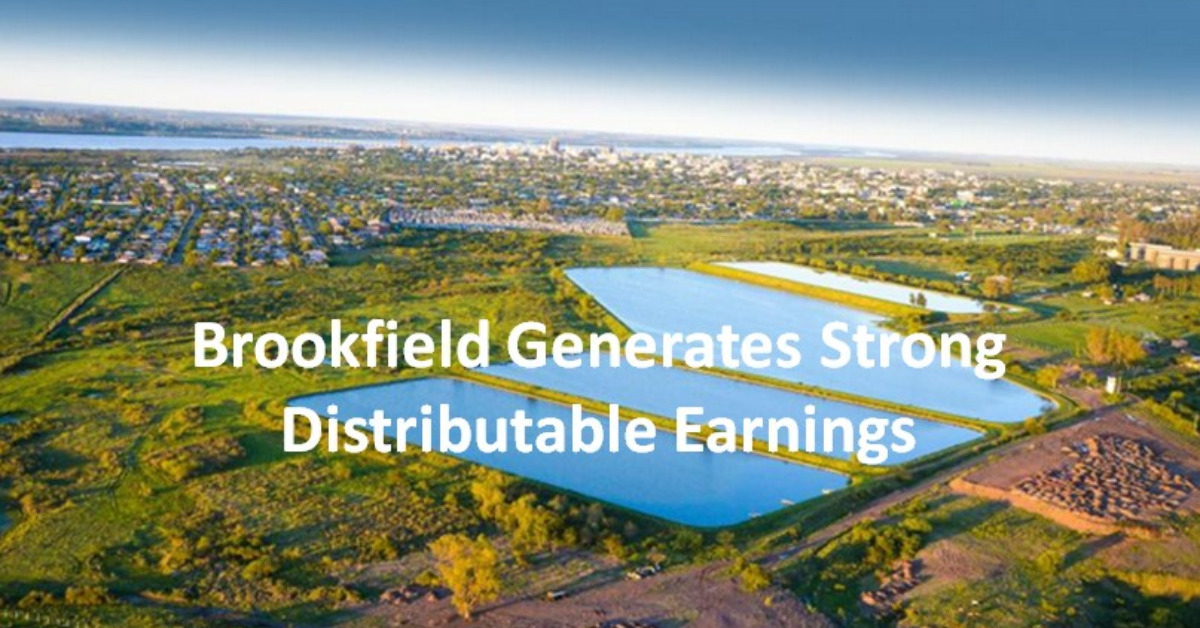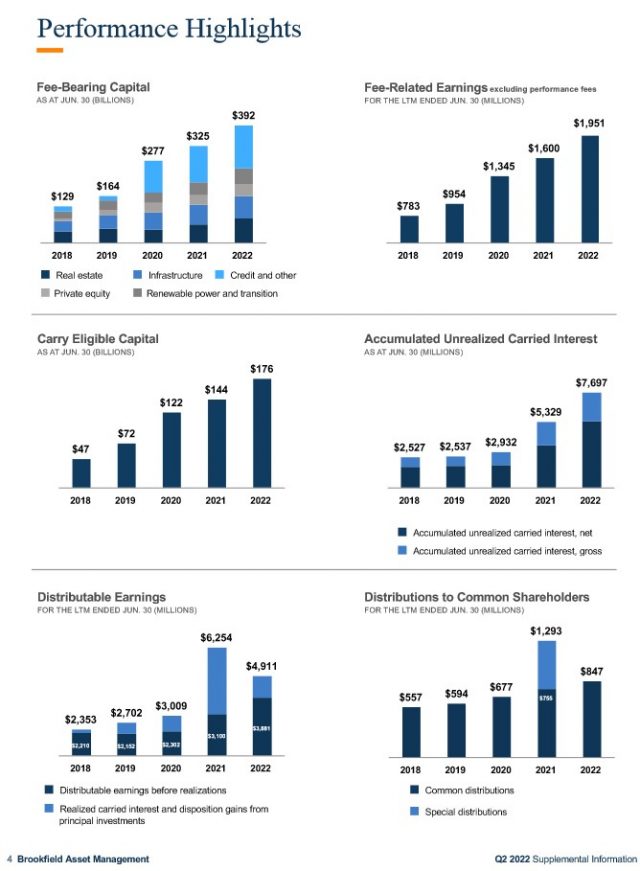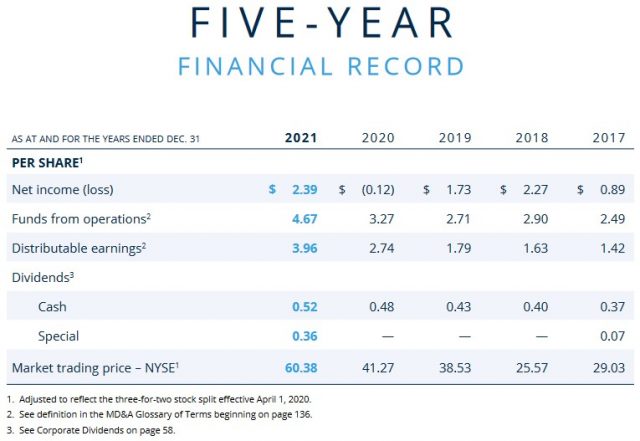Contents

Brookfield Asset Management (BAM-a.TO and BAM) generates strong Distributable Earnings. This makes it a great long-term investment for investors seeking exposure to asset managers.
I have reviewed it several times with my most recent post being a May 20 guest post at Dividend Power. In that post, I touch upon its intent to transition to an asset-light model much like Blackstone (BX). In addition, Portfolio Insight asked authors of leading investing websites to share the 10 best dividend stocks. I recommended BAM and BX. The remaining 8 companies were recommendations by other guest contributors.
With the release of Q2 and YTD2022 results on August 11, 2022, I revisit BAM to determine if I should acquire additional shares.
NOTE: The company is authorized to issue an unlimited number of Class A Limited Voting Shares ('Class A shares') and 85,120 Class B Limited Voting Shares ('Class B shares'); insiders hold the Class B shares. BAM conducts more of its operations in USD than any other single currency. Given this, the USD dollar is BAM's functional and reporting currency for purposes of preparing consolidated financial statements.
Transition to An Asset Light Model
In Q1 2022 CEO Letter to Shareholders, investors learn that BAM's senior executive and Board members concluded that publicly listing a 25% interest in the asset management business would be overwhelmingly positive.
Expectations are for the distribution of these shares to shareholders before the end of 2022. The special distribution of shares of the Manager, based on estimated value, would be ~$20B or ~$12.00 for each share of Brookfield Asset Management currently owned by each shareholder; this distribution would be executed on a tax-free basis to Canadian and U.S. shareholders.
Fast forward to August 11, 2022, and we learn that the company currently known as Brookfield Asset Management Inc. (BAM) will be renamed Brookfield Corporation following the split. It will retain most of the proprietary capital owned by Brookfield, as well as continue to own 75% of Brookfield Asset Management Ltd. ('the Manager'); this will be the new entity formed to manage the current ~$750B in assets under management (AUM).
Further details on this restructuring are provided in the Q2 2022 CEO Letter to Shareholders.
Industry and Business Overview
I dispense with an Industry and Business Overview because I covered this in my May 20, 2022 guest post. Investors can also learn much more about the BAM group of companies by reading the beginning of its FY2021 Annual Report.
Financials
Q2 2022 and YTD Results
BAM's Q2 2022 Earnings Release and Supplemental Information reflect another strong quarter.
Although GAAP Earnings only reflect $1.16 in YTD diluted EPS and YTD Net Earnings of $4.435B, this is not a good metric by which to assess BAM's performance. Superior metrics by which to assess BAM's performance are:
- Funds from Operations (FFO);
- Distributable Earnings (DE); and
- Carried Interest (CI).
The Glossary of Terms at the end of the Supplemental Information document (starting on page 39 of 43) describes the non-IFRS (International Financial Reporting Standards) metrics BAM uses to convey its performance to the investment community.
DE, for example, excludes mark-to-market valuations. This means the results will be more stable, especially during market turmoil. The measure also includes cash income from asset sales and management fees. On the other hand, economic net income (EPS) includes both realized and unrealized gains or losses and requires private assets to be marked to market.
Fundraising efforts remained strong with record inflows of $56B since the end of Q1 2022. BAM's flagship fundraising continues to progress well and it is now planning for the next round of flagship fundraising. It also continues to raise and deploy capital across various perpetual strategies.
BAM's underlying businesses are essential. They, therefore, continue to generate stable and growing cash flows throughout cycles. These assets are highly cash-generative with high margins and are largely inflation protected. As a result, they are very attractive to buyers through market cycles.
Since the end of Q1 2022, BAM has sold $21B of assets at premium valuations of which $10B were asset sales within BAM's real estate business; it recognized $5B of gains on these sales. Notable sales during the quarter include BAM's UK student housing business which sold for $4.3B and the Los Angeles ports business for $1B. These assets generated exceptional returns and further added to BAM's investable liquidity available to be deployed into new opportunities. Several other sales processes are currently underway and BAM's monetization pipeline remains very strong.
DE in Q2 was $1.2B and $4.9B over the last 12 months. DE before realizations, a measure of BAM's recurring annuity-like cash flows were $1B for Q2 and $3.9B over the last 12 months; this is a 26% increase compared to last year.
FFO and net income totalled $1.4B and $1.5B, respectively for the quarter. In Q2 and the beginning of Q3, BAM had record inflows of $56B of which $41B was raised in Q2 and $15B after quarter-end.
BAM held a final close for its inaugural transition fund, raising $15B in total. It is now finalizing the first closes of its sixth private equity fund and fifth infrastructure fund for ~$8B and ~$20B, respectively. It has also raised $14.5B for its flagship real estate fund and expectations are for a final close in the Fall of 2022. The $16B flagship opportunistic credit fund is moving to 80% invested or committed and plans are to start fundraising for the next vintage later this year.
BAM ended Q2 with $392B of fee-bearing capital which was up 21% compared to the prior year; this excludes the $15B that was raised after quarter end.
Fee-related earnings were $0.525B in Q2 and $2B over the last 12 months. This represents increases of 30% and 22% from the prior periods, excluding the benefit of performance fees earned in the prior year.
In addition to the current fee-bearing capital, BAM has $36B of additional committed capital that, when invested, will translate to ~$0.36B of incremental annual fee revenue. This plus the additional capital raised across the latest flagship series will be a continued tailwind for growth in earnings.
On the capital deployment front, BAM committed or invested $36B of capital. This includes the $5.1B deployed to acquire American National to further expand the reinsurance business, $8.5B to acquire CDK Global, a car dealership software business, and $3B of real estate assets at a significant discount to intrinsic value.
BAM and DigitalBridge To Acquire A 51% Stake in Deutsche Telekom Towers
Europe’s phone carriers used to insist on ownership of their infrastructure including masts and fixed networks. However, after facing pressure to share the bill for expensive investments into fibre optics and 5G, combined with significant debt obligations and stagnant share prices, they have started to spin off or sell the businesses.
Following the end of Q2, Deutsche Telekom AG agreed to sell a 51% stake in its towers unit to BAM and DigitalBridge Group Inc. (a US private equity firm) in a deal that values the business at 17.5B euros (US$17.5B); Deutsche Telekom will retain a 49% stake. This is one of the largest digital infrastructure deals YTD.
BAM and DigitalBridge Group teamed up in a last-minute bid for the stake, emerging as the frontrunner ahead of a KKR & Co.-led consortium. BAM's previous partner, Cellnex Telecom SA, had dropped out of the bidding for undisclosed reasons.
Insurance Solutions
Amid unprecedented economic shutdowns and stimulus programs across much of the world in 2020, BAM decided to pursue the build-out of an Insurance Solutions business. This business would combine BAM's investment capabilities with its access to capital and prudent risk management to help insurance companies in the U.S., Canada, and Europe manage capital efficiency, invest for higher yields, and transfer risk. In conjunction with this effort, BAM:
- spun out Brookfield Reinsurance;
- acquired American National, a domestic U.S. insurer with operations that cover life, annuities, and property and casualty; and
- completed a strategic partnership with American Equity Life, while also entering into some reinsurance transactions.
In all, it deployed $4B of equity capital and established itself as a key long-term partner to frontline insurers. These efforts have resulted in BAM now managing over $40B of insurance assets, coupled with long-duration, low-rate, annuity-based reserves.
Over the past several years, BAM maintained its patient approach to capital allocation. It purposely kept its portfolio in a short duration and highly liquid position, maintaining ~$25B of assets in the form of cash and liquid securities with the balance invested in accretive, Brookfield, and Oaktree funds or into direct private credit opportunities. As a result, BAM is now in a position to invest capital for value and drive outsized returns.
Currently, with a high degree of cash and liquid securities on the Balance Sheet, the insurance solutions business earns more than $0.4B of DE on an annualized basis. Roughly $50 million of this amount is in the form of investment management fees. As BAM deploys excess capital, expectations are for DE to increase to over $0.8B annually.
Pension Risk Transfer (PRT)
BAM continues to scale its Canadian PRT business. This business has been built over the last six years, growing to more than $3B in insurance assets. This is a $1T market with ~$5B of PRT annuities coming to the market each year.
In the last two years, BAM has been successful in closing more than $1B in PRT annuities each year. This places it in the top one or two in market share in this rate environment. This year's activity includes closing on the single largest PRT transaction ever completed in the Canadian market for ~$1B.
Further growth of its PRT efforts through expansion into the US and European markets is expected. These are both well-established markets that offer significant scale, where BAM can leverage its corporate relationships and the broader BAM global presence. Expectations are for more than a doubling of annual PRT sales in the coming years.
FY2022 Guidance
BAM is continually acquiring and divesting assets. This makes it virtually impossible for it to provide any guidance.
Credit Ratings
The senior unsecured domestic long-term debt ratings assigned by the major rating agencies are:
- S&P Global assigns an A- long-term unsecured debt credit rating with a stable outlook; and
- Fitch assigns an A- long-term unsecured debt credit rating with a stable outlook;
- Moody's assigns Baa1 long-term unsecured debt credit rating with a stable outlook. This is one tier lower than Fitch's and S&P Global's ratings.
S&P Global's and Fitch's ratings are the lowest tier in the upper-medium-grade investment-grade tier. Moody's rating is the top tier within the lower-medium-grade investment-grade tier.
S&P Global and Fitch define BAM as having a STRONG capacity to meet its financial commitments. It is, however, somewhat more susceptible to the adverse effects of changes in circumstances and economic conditions than obligors in higher-rated categories.
Moody's defines BAM as having an ADEQUATE capacity to meet its financial commitments. However, adverse economic conditions or changing circumstances are more likely to lead to a weakened capacity to meet its financial commitments.
These ratings satisfy my conservative investment preferences.
Dividend and Dividend Yield
BAM distributes a quarterly dividend with the next USD $0.14/share quarterly distribution scheduled for September 29. With the US shares trading at ~$53.72, the dividend yield is ~1%.
Investors whose investment decisions are heavily influenced by a company's dividend metrics likely find BAM to be an unappealing investment. However, once BAM completes the proposed spin-off of its asset management business in late 2022, the quarterly payout will change and the dividend yield will most likely rise above historical levels.
BAM's CEO has stated that:
'Since asset managers don’t need much in the way of facilities, equipment or working capital to do business, we plan for the Manager to pay out ~90% of its annual earnings in dividends.'
Although BAM’s quarterly dividend distribution will likely be unpredictable, the dividend distribution should grow over the very long term.
Given the proposed spin-off which is expected to be completed in late 2022, I suggest investors pay little attention to BAM’s historical dividend track record.
Although BAM does repurchase shares, the share count has steadily increased over the years. The outstanding number of shares at the end of Q2 2021 and 2022 and the last 12 months is reflected below.
I have no issue with the increase in the number of outstanding shares as long as the undervalue of each share appreciates over the long term.
Valuation
Trying to gauge BAM's valuation using the commonly used Price/Earnings ratio can lead to incorrect investment decisions.
Asset managers, such as BAM, raise pools of funds from clients in the tens of billions of dollars. These funds are then deployed toward multiple acquisitions. In BAM's case, it makes multiple billion-dollar acquisitions annually and the magnitude of these acquisitions grows significantly over time.
BAM uses its expertise to improve the performance of the acquired companies with the intent of monetizing these assets as part of its capital recycling programs. These dispositions often generate large proceeds for clients, principal investment proceeds for BAM, and substantial carried interests. It is not, therefore, unusual to see wide swings in YoY GAAP results.
As noted earlier, BAM uses superior metrics by which to assess its performance of which 2 are:
- Funds from Operations (FFO); and
- Distributable Earnings (DE).
The following tables reflect the disparity between Net Income (GAAP), FFO, and DE. Net Income (GAAP) can fluctuate widely YoY. Meanwhile, FFO and DE during the FY2017 - FY2021 timeframe reflect a steady increase. This is because FFO and DE account for activities that are part of BAM's normal course of business. GAAP metrics, however, do not.

Source: BAM Q2 2022 Supplemental Information
BAM acquires some assets meant to be perpetual holdings. In other cases, it uses its expertise to improve the performance of the companies in which it invests with the intent of monetizing these assets as part of its capital recycling programs.
We also have to consider that market conditions can lead to very wide swings in GAAP earnings.
It is not, therefore, unusual to see wide fair value changes in amounts attributable to consolidated entities and equity accounted investments; an accounting rule requires BAM to report unrealized gains and losses.
BAM is not alone in having to report fair value changes. In my Berkshire Hathaway Is Better Than A Broad-Based ETF post, I mention the reason unrealized gains and losses must be reported is that a GAAP rule imposed in 2018 requires a company to include in earnings the net change in the unrealized gains and losses of its investments. These unrealized gains and losses are paper losses and not actual realized gains and losses that come from any sale.
Warren Buffett often urges investors to ignore such gains and losses.
I envision BAM's FFO, FRE, and DE will fluctuate but will rise over the long term. This is because BAM:
- continually raises new pools of capital;
- the extent to which it acquires or disposes of assets should increase as the level of Assets Under Management (AUM) grows; and
- the timing of asset sales and dispositions is highly unpredictable.
Final Thoughts
Brookfield generates strong DE making it a great long-term investment for investors seeking exposure to asset managers. It does not, however, operate in a vacuum. Were we to encounter another 'Financial Crisis', BAM's short-term results would likely experience weakness. BAM, however, raises large pools of capital from highly sophisticated investors who have a long-term investment time horizon and who commit to investing for several years. Therefore, BAM should not need to urgently liquidate assets to raise funds to return to its investors. On the contrary, BAM's access to sophisticated investors with 'deep pockets' makes it likely that it would be in a position to acquire assets at favourable valuations.
I have been a BAM shareholder since February 12, 2009 and over the years have gradually increased my exposure to the various entities within the group. At the time of my Mid-2022 Investment Holdings Review, the BAM group of companies was my 11th largest holding. When I completed my January 7, 2022 review, it was my 10th largest holding. In mid-April 2021 it was my 11th largest and in mid-August 2020 it was my 13th largest.
Much has changed in the last 1.5 months; I have added to several positions and there has been a considerable change in the share price of several holdings. I am, however, reasonably confident BAM is still a top 15 holding.
On July 18, 2022, I acquired additional BAM shares @ $58.34 CDN in a 'Core' account in the FFJ Portfolio. BAM's share price has subsequently surged to $68.55 CDN as I compose this post.
In the short run, the market is a voting machine. In the long run, however, it is a weighing machine. BAM's share price could continue to rise in the short term. An event of some magnitude, however, is highly likely to occur at some point which will lead to a pullback in BAM's share price. That will be when I want to add to my BAM exposure!
I wish you much success on your journey to financial freedom!
Note: Please send any feedback, corrections, or questions to [email protected].
Disclosure: I am long BAM.
Disclaimer: I do not know your circumstances and do not provide individualized advice or recommendations. I encourage you to make investment decisions by conducting your own research and due diligence.
Consult your financial advisor about your specific situation.
I wrote this article myself and it expresses my own opinions. I do not receive compensation for it and have no business relationship with any company mentioned in this article.



